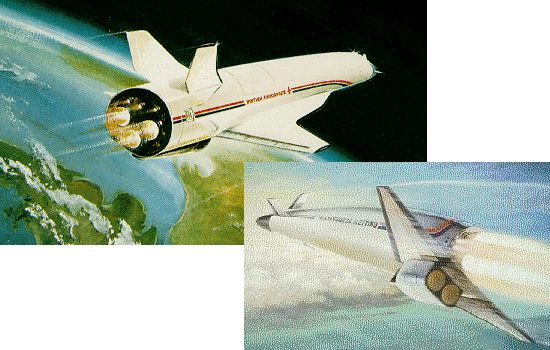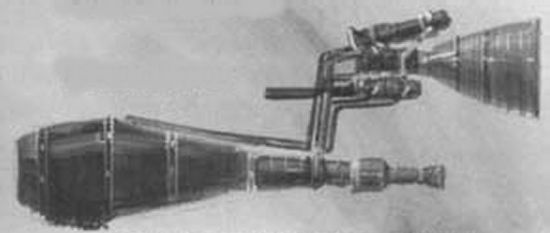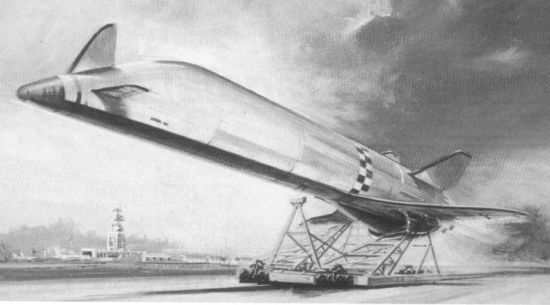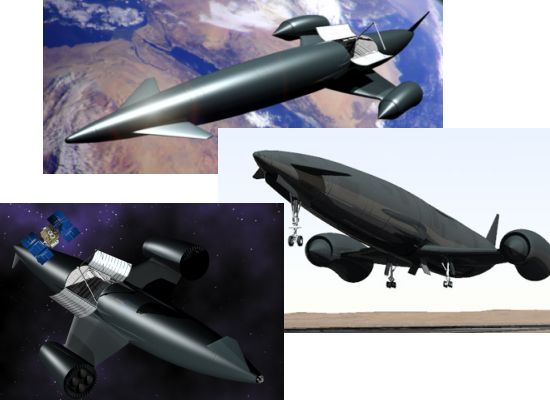|
||||||||||
|
|
||||||||||
|
||||||||||
|
|
||||||||||

The HOTOL project traces its roots to 1982 when an experienced rocketry engineer named Alan Bond began researching a new airbreathing rocket engine. Patented in 1983, Bond's concept was intended to solve a major hurdle faced by those trying to develop SSTO vehicles. The design of such craft has always been hampered by the need to carry all of the propellant, both fuel and oxidizer, aboard the vehicle. This requirement makes the craft very large and heavy. As a result, most designers have chosen to use staged rockets that can dispose of excess weight as the vehicle ascends into orbit.
Bond's idea was to reduce the initial size of the craft by eliminating the need to carry any oxidizer aboard the vehicle for the early portions of flight. Instead, his engines would take in oxygen from the external atmosphere, mix it with liquid hydrogen carried aboard the vehicle, and burn the mixture to generate thrust similarly to a conventional jet engine. Bond's engine would function in this manner until the vehicle reached a speed of Mach 5.5. At this point, the craft would be at such a high altitude that the air would be too thin to supply oxygen for the engines. The remainder of the flight would instead be completed by mixing the liquid hydrogen with a supply of liquid oxygen carried aboard the vehicle, and the engines would switch to operating like conventional rockets.

Around the time Bond was finalizing his engine design, Robert Parkinson of British Aerospace (BAe) was also conducting a study of a reusable launch vehicle. The matching of Bond's engine with the launch vehicle proved an attractive concept. Rolls Royce bought rights to Bond's engine, now dubbed the RB545, and joined with BAe to launch the HOTOL project in 1985. HOTOL became an official national program in 1986 when the UK government pledged £2 million for a two-year proof-of-concept study.
Robert Parkinson of BAe and John Scott of Rolls Royce led this study, and Alan Bond remained extensively involved. The design that emerged looked similar to a conventional aircraft except the propulsion system was mounted within the aft fuselage of the vehicle. This region of the craft also housed the heavy liquid oxygen tanks. Because so much weight was concentrated near the aft end of the HOTOL, balancing its center of gravity against the center of pressure became critical. This requirement forced designers to locate the wings far aft as well so that their lift counteracted the weight of the engines while maintaining stability. Meanwhile, the forward fuselage contained the liquid hydrogen tanks and a payload bay for up to 7 tons of cargo.

Unfortunately, the flight characteristics of this layout proved to be quite poor because of an enormous shift in center of pressure across the large range of Mach numbers experienced during the airbreathing portion of flight. This problem was similar to that experienced on the Concorde but far more severe given the much larger speed range. The design of the fuselage and wing had to be significantly modified to alleviate this mismatch between the centers of pressure and gravity, but at the cost of reducing the payload capacity. In an effort to gain back some small additional payload, designers were even forced to abandon conventional landing gear in exchange for a rocket-powered sled that boosted the HOTOL off the runway before being jettisoned.

These and other operational disadvantages of the concept caused the design team to resort to increasingly untried and experimental structural materials and construction techniques in order to launch a reasonable payload at an economical cost. These technical difficulties convinced the British government to withdraw its support and cancel any further funding for HOTOL in 1988. Shortly thereafter, Rolls Royce also pulled out of the program.
However, the project gained a new lease on life in 1990 when BAe approached the Soviet Union about launching a derivative of the HOTOL by piggybacking aboard the massive Antonov An-225 transport. Known as the Interim HOTOL, this smaller vehicle would abandon the complex RB545 engines in favor of conventional rockets supplied by Russia. Interim HOTOL would be mounted above the An-225, originally designed to carry the Buran space shuttle, and carried to an altitude of about 29,500 ft (9,000 m). Once released, the Interim HOTOL would then ignite its rocket engines and be boosted into orbit while carrying 4.5 tons of cargo.

Antonov also investigated developing a more capable derivative of the An-225 called the An-325 with two additional engines that could carry a greater payload and possibly launch a larger version of HOTOL or a Russian vehicle. Unfortunately, Interim HOTOL fared little better than its predecessor and was cancelled in 1992 due to a lack of interest from either the European Space Agency (ESA) or the UK government.
Despite the failure of HOTOL itself, the basic idea still lives on even today in the form of a new vehicle called Skylon. Shortly after the cancellation of HOTOL in 1988, members of the Rolls Royce engine design team decided to form a new company, Reaction Engines Ltd., to continue developing the HOTOL concept. Led by Alan Bond, Reaction Engines developed a new improved version of the RB545 engine called the SABRE (Synergic Air Breathing Engine).

Like the RB545, the Sabre engine operates similarly to a gas turbine during takeoff and the initial climb by combusting liquid hydrogen with oxygen from the external atmosphere. As the Skylon climbs and the air becomes thinner, the engine gradually transitions to rocket mode using an onboard supply of liquid oxygen. In this way, the same propulsion system can operate from takeoff to orbit, or 0 to Mach 25. This propulsion system shares many common elements between the jet and rocket to save weight and is a more compact design than the RB545. This improvement in packaging makes it possible to move the propulsion installation out of the fuselage and to the wingtips, much like the SR-71 Blackbird.

The Skylon concept weighs 275 metric tons at launch carrying 66 metric tons of liquid hydrogen and 150 metric tons of liquid oxygen. The vehicle is reportedly designed to carry up to 12 metric tons into orbit, and its payload bay has been sized around standard air cargo containers. Its designers also claim that a 30-passenger module could be carried within the bay once the Skylon was man-rated. Skylon does away with the rocket sled needed on HOTOL and is capable of taking off and landing using retractable landing gear. The craft would weigh 55 metric tons at landing and only 41 metric tons empty. Its structure is made up primarily of composite materials, and the heat of re-entry is said to be dissipated by "layers of reflecting foil."

Although Reaction Engines has been pursuing this concept for over 15 years, it does not appear to have attracted
much interest. In 1992, the company estimated that it would take 10 years and $10 billion to develop the Skylon.
To date, the group has only been able to raise a small fraction of that total, most of which has been invested into
basic research on the Sabre engine. Given the number of unproven technologies incorporated into its design and the
lack of capital to develop them, it seems unlikely that Skylon will be completed anytime soon. Additional
information is available at Reaction Engines.
- answer by Jeff Scott, 14 November 2004
Read More Articles:


|
Aircraft | Design | Ask Us | Shop | Search |

|
|
| About Us | Contact Us | Copyright © 1997- | |||
|
|
|||